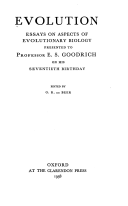Ontogeny and Phylogeny
A living organism must be studied from two distinct aspects. One of these is the causal-analytic aspect which is so fruitfully applicable to ontogeny. The other is the historical descriptive aspect which is unravelling lines of phylogeny with ever-increasing precision. Each of these aspects may make suggestions concerning the possible significance of events seen under the other, but does not explain or translate them into simpler terms.
Notes:
Two important ways of looking at an organism: it's origin and structure, and it's taxonomical location.
Folksonomies: biology perspectives study
Taxonomies:
/science/biology (0.576057)
/society/senior living (0.496429)
/science/mathematics/statistics (0.294738)
Keywords:
historical descriptive aspect (0.917504 (positive:0.455121)), taxonomical location (0.768442 (positive:0.277306)), living organism (0.757763 (neutral:0.000000)), causal-analytic aspect (0.745258 (positive:0.602558)), ever-increasing precision (0.725744 (positive:0.455121)), unravelling lines (0.706012 (positive:0.455121)), important ways (0.701725 (positive:0.248409)), simpler terms (0.683031 (neutral:0.000000)), distinct aspects (0.676823 (neutral:0.000000)), possible significance (0.663895 (neutral:0.000000)), Ontogeny (0.596689 (positive:0.248409)), phylogeny (0.578410 (positive:0.351765)), suggestions (0.383759 (neutral:0.000000))
Concepts:
Recapitulation theory (0.932431): dbpedia | freebase | yago
Biology (0.875092): dbpedia | freebase | opencyc
Organism (0.858164): dbpedia | freebase
Phylogenetics (0.780883): dbpedia | freebase
Species (0.698076): dbpedia | freebase | opencyc
Evolution (0.691784): dbpedia | freebase | opencyc





